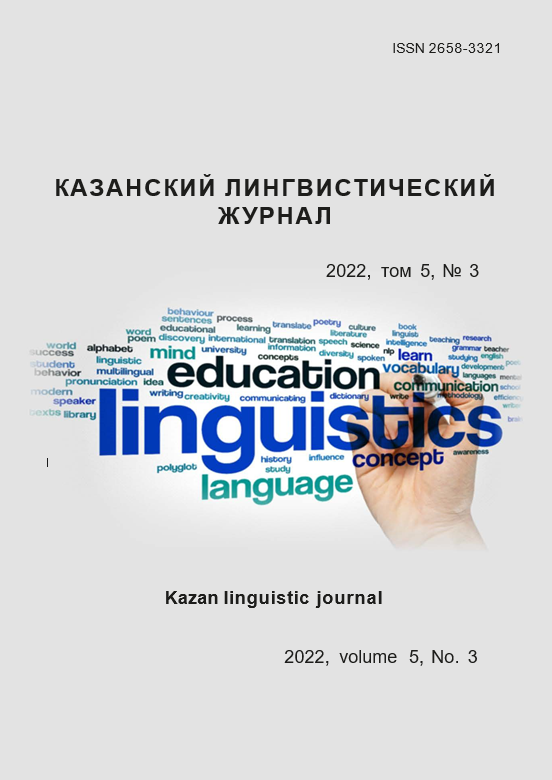Semantic field of the derivative nest *cap in the Russian language
https://doi.org/10.26907/2658-3321.2022.5.3.338-345
Keywords:
Indo-European languages, etymology, word formation, root nest, semantic field, lexical-semantic group, language sign demotivationAbstract
The purpose of this article is to build a semantic field "head" by means of borrowed lexemes containing the root *cap, as a result proof through etymological and derivational analysis of belonging to the same root nest of words that often have lost their original motivation. The material of the study is the lexemes of the Russian language, recorded in explanatory, derivational, etymological dictionaries, obtained by continuous sampling. In addition, the genetic origin of the Latin root *сaр from the Indo-European sound-symbolic root *kaр, which has undergone changes in terms of semantics and structure, is established. As a result of etymological and word-formation analyzes, it was possible to identify the nuclear concept “head”, which is a literal translation of the Latin word “caput”, which in turn in Russian has a branched seme structure consisting of 9 sememes. Despite the wide semantic range of the word in Russian, as shown by content analysis, within the central part of the semantic field of the root *cap, it is possible to distinguish lexemes that are included in only 3 lexico-semantic groups: “round object”, “front, upper part of something", "a person who is at the head of something / someone." The words caprice (kapriz), kapron (kapron) and capon (kaplun) remained on the periphery, having lost their natural motivation with a producing root.
References
References
Petukhova E.V. Indo-European sound symbolic root *kap-/ghabh in modern English and Russian. Vestnik Yuzhno-Ural'skogo gosudarstvennogo gumanitarno-pedagogicheskogo univer-siteta. 2016; 2: 180-185. (In Russ.)
Susov I.P. History of Linguistics. Moscow: AST: Vostok-Zapad; 2006. (In Russ.)
Mullagalieva A.G. Functional and semantic features of the etymological nest *gi in the Russian language: abstract of the dissertation of the Candidate of Philological Sciences. Kazan State University. Kazan; 2006. 23 p. (In Russ.)
Zakharova Yu.G., Melnichenko E.V. Etymological nest with root *mxr in Russian. Studia Humanitatis. 2018; 8:34-39. (In Russ.)
Balalaeva E.Y. Verbs of onomatopoeic origin, going back to the Indo-European roots *bha*ba. Studia Humanitatis. 2019; 3: 45-52. (In Russ.)
Vinogradov V.V. Selected works. Russian Grammar studies. Moscow: Nauka; 1975. (In Russ.)
Baudouin de Courtenay I.A. Selected works on general Linguistics. Moscow; 1963. (In Russ.)
Fortunatov F.F. Selected works. Moscow: Uchpedgiz; 1957. (In Russ.)
Vinokur G.O. Notes on Russian word formation. Selected works. M.: Uchpedgiz; 1959. (In Russ.)
Shansky N.M. Essays on Russian word formation. 2nd ed. Moscow; 2005. (In Russ.)
Kubryakova E.S. What is word formation? Moscow 1980. (In Russ.)
Gabdreeva N.V. French vocabulary in the Russian language: historical and functional research: abstract of the dissertation. ... Doctor of Philological Sciences. Kazan State University. Ka-zan, 2001. (In Russ.)
Chupryakova O.A., Safonova S.S. Verbal vocabulary of Russian dialects of the Vol-ga-Kamya: semantics and word production. Kazan: Otechestvo; 2015. (In Russ.)
Flaxman M.A. Diachronic development of the sound-imaginative vocabulary of the English language: abstract. dis. ... Candidate of Philological Sciences. SPb.; 2015. (In Russ.)
Tikhonov A.N. Word-Formation Dictionary of Russian / Edition of B.A. Larin: In 2 Vol. M.: Russian, 1985; 1: 856. (In Russ.)
Ozhegov S.I., Shvedova N.Yu. Explanatory dictionary of the Russian language: 120,000 words and phraseological expressions. Russian Academy of Sciences. V.V. Vinogradov Institute of the Russian Language. 4th ed. Supplemented. M.: LLC "A TEMP", 2017. 896 p. (In Russ.)
National Corpus of the Russian language. Available from: https://processing.ruscorpora.ru [accessed 22.07.2022]. (In Russ.)






